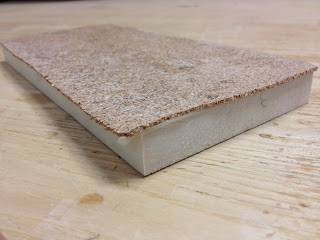This Module 5 we decided to make a shooting board. A shooting board is a jig woodworkers use in conjunction with our hand planes to produce square ( or other desired angles ) boards.
We will use Paul Sellers' shooting board design, only slightly altered. However we must produce square stalk to build the shooting board, hence the chicken or egg dilemma.
So here we go. Practicing on Basswood, students produced a square board 4" wide, 9" long, 3/4" thick using layout tools and hand planes ( SHARP ONES ).
There are six sides to a board and so six steps to square one up.
Step 1 is to flatten a face. Andy uses his scary sharp block plane to smooth and flatten the first face of his board.
He checks for flatness with a straight edge.
Light will appear under the edge where low points occur
Andy then takes his time to analyze where the low points are and planes off where they are not.
A Flat Board will fall onto a flat surface with a thhhhhump.
You can hear all the air move out of the way as the flat face hits the flat table saw surface in the video below.
And the difference as it knocks around the uneven backside
 |
| the layout for step 3 is shown |
 Once the first face is flat,William moves to step 2, Square one edge to the flat face.
Once the first face is flat,William moves to step 2, Square one edge to the flat face.Checking with a square off the flat face, light is visible again on the low points.
Accuracy is only possible with a sharp plane.
One strategy used to obtain our square objective is to shade high points with our pencil and them take them off with our plane.
This targets only the high points.
Don't forget to constantly verify if you are square.
Watch Mélanie Target those pencil marks below.
Step 3 Now that we have completed step 1 and 2, The other sides or steps are really interchangeable.
The reason is because our layout tools will always register from either the first face or first edge made.
Paralleling from the opposite edge in done with a marking gauge or combo square. This line is 4" from the Original edge. Layout lines can be scored with a knife too. It is more accurate as we can use "THE FORCE" and feel the layout line. Don't forget to make sure the parallel edge is square with the first face.
 |
| step 3 was to parallel the second edge to the first. |
Planing down more than 1/2" can be time consuming and cause one arm to be larger than the other. Safely cutting 1/8" over the layout line with a rip saw will do the trick.















No comments:
Post a Comment